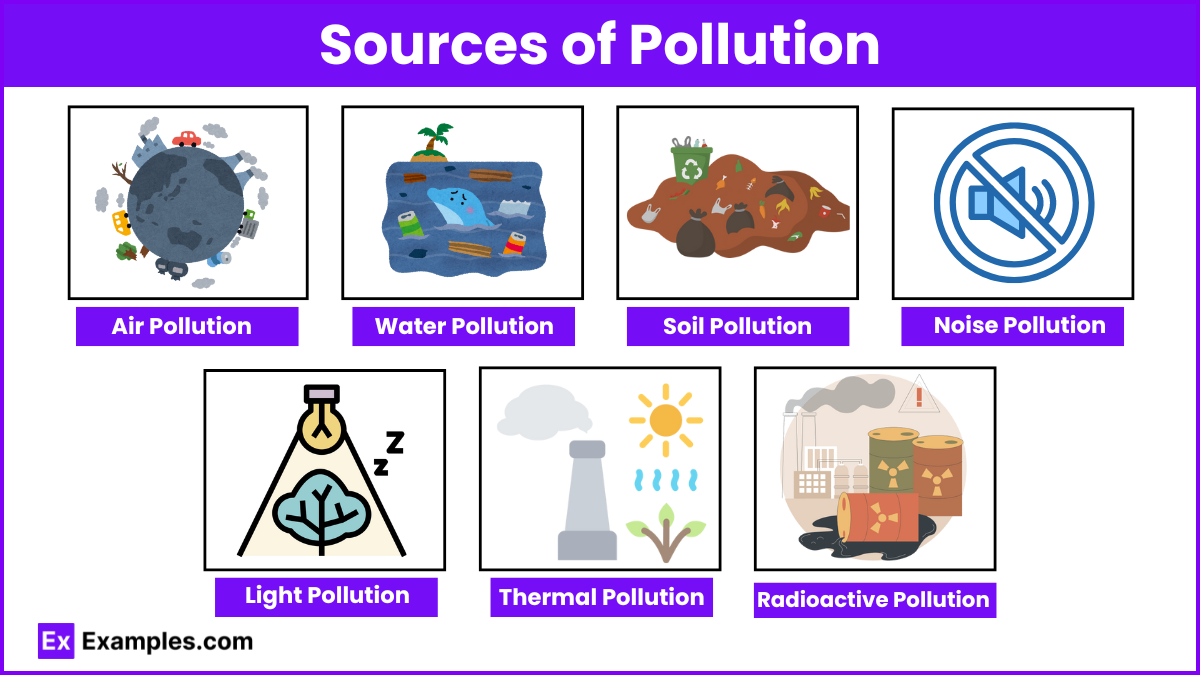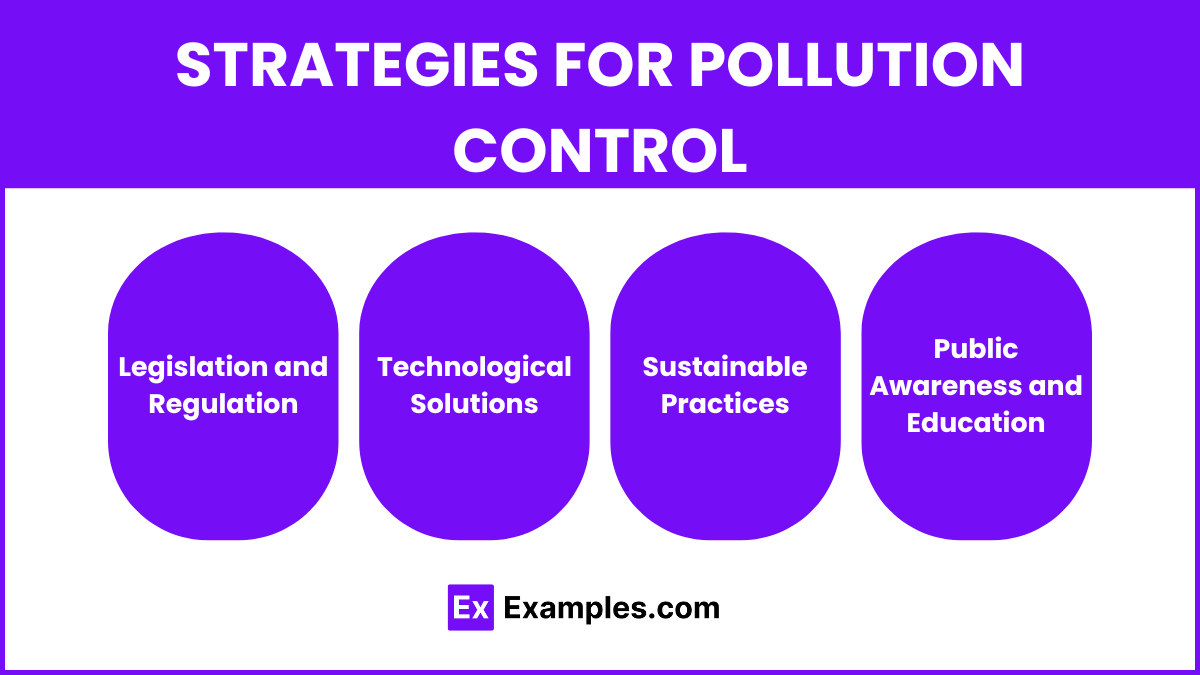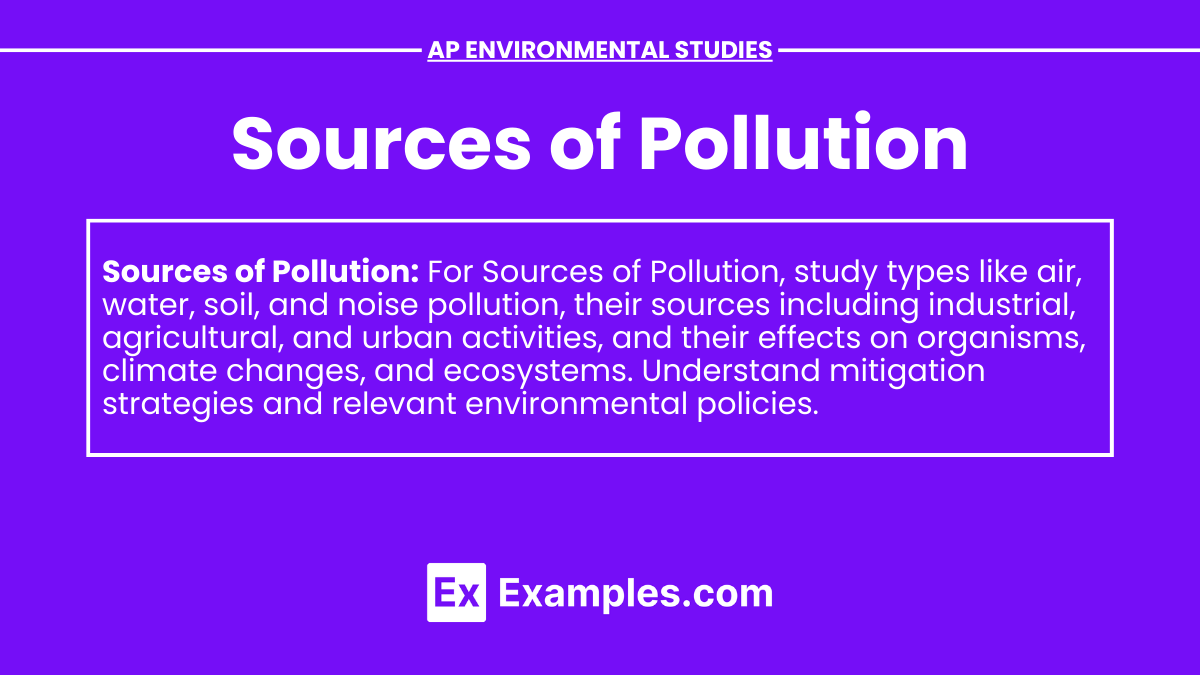Sources of pollution significantly impact the biosphere, disrupting ecology, ecosystems, and biodiversity. In AP Environmental Science, understanding these sources—such as industrial emissions, agricultural runoff, and urban waste—is crucial. These pollutants degrade air, water, and soil quality, threatening the health and stability of diverse biological systems. Addressing pollution sources is essential for maintaining the balance and resilience of our planet’s ecosystems and overall biosphere.
Learning Objectives
By studying sources of pollution, students will understand how various pollutants affect organisms, disrupt flora and fauna, and contribute to climate changes. Learning objectives include identifying pollution sources, analyzing their impacts on ecosystems, and exploring mitigation strategies. Students will also examine how pollutants alter habitats, affect biodiversity, and exacerbate environmental issues like global warming. This knowledge is vital for developing solutions to protect organisms and maintain ecological balance.
Sources of Pollution

1. Air Pollution
Sources:
- Industrial Emissions: Factories release pollutants like sulfur dioxide (SO₂), nitrogen oxides (NOₓ), and particulate matter.
- Vehicle Emissions: Cars and trucks emit carbon monoxide (CO), hydrocarbons (HC), and nitrogen oxides (NOₓ).
- Agricultural Activities: Use of pesticides and fertilizers releases ammonia (NH₃) and other chemicals into the air.
- Natural Sources: Volcanic eruptions, wildfires, and dust storms contribute to air pollution.
Key Pollutants:
- Particulate matter (PM10 and PM2.5)
- Ozone (O₃)
- Carbon monoxide (CO)
- Sulfur dioxide (SO₂)
- Nitrogen oxides (NOₓ)
2. Water Pollution
Sources:
- Industrial Discharges: Factories release toxic chemicals, heavy metals, and waste into water bodies.
- Sewage and Wastewater: Untreated sewage from households and industries contaminates water.
- Agricultural Runoff: Pesticides, fertilizers, and animal waste runoff into rivers and lakes.
- Oil Spills: Accidental spills from oil tankers and drilling rigs pollute oceans and seas.
Key Pollutants:
- Heavy metals (lead, mercury, cadmium)
- Nutrients (nitrates and phosphates)
- Pathogens (bacteria, viruses)
- Organic pollutants (pesticides, solvents)
- Sediments
3. Soil Pollution
Sources:
- Agricultural Activities: Excessive use of pesticides, herbicides, and fertilizers.
- Industrial Activities: Disposal of industrial waste, heavy metals, and chemicals.
- Urban Waste: Improper disposal of household garbage, plastics, and electronic waste.
- Mining Activities: Release of harmful chemicals and heavy metals from mining operations.
Key Pollutants:
- Pesticides and herbicides
- Heavy metals (lead, arsenic, mercury)
- Hydrocarbons
- Plastics and microplastics
4. Noise Pollution
Sources:
- Transportation: Road traffic, airplanes, and trains.
- Industrial Activities: Factories and construction sites.
- Urban Areas: Loud music, parties, and commercial activities.
- Recreational Activities: Concerts, sports events, and personal use of loud equipment.
Effects:
- Hearing loss
- Stress and anxiety
- Sleep disturbances
- Wildlife disruption
5. Light Pollution
Sources:
- Urban Areas: Streetlights, commercial buildings, and advertising billboards.
- Residential Areas: Outdoor lighting, security lights.
- Recreational Activities: Stadium lighting and outdoor events.
Effects:
- Disruption of ecosystems and wildlife
- Interference with astronomical observations
- Human health issues (sleep disorders)
6. Thermal Pollution
Sources:
- Power Plants: Discharge of heated water into rivers and lakes.
- Industrial Processes: Release of hot water from manufacturing plants.
- Urban Runoff: Warm water runoff from paved surfaces.
Effects:
- Decreased oxygen levels in water bodies
- Disruption of aquatic ecosystems
- Thermal shock to aquatic organisms
7. Radioactive Pollution
Sources:
- Nuclear Power Plants: Accidents and leaks.
- Medical Waste: Disposal of radioactive materials from hospitals.
- Nuclear Weapons Testing: Release of radioactive isotopes.
- Industrial Activities: Use of radioactive materials in manufacturing.
Effects:
- Genetic mutations
- Cancer and other health issues
- Contamination of soil and water
Strategies for Pollution Control

- Legislation and Regulation
- Clean Air Act
- Clean Water Act
- Resource Conservation and Recovery Act
- Technological Solutions
- Emission Control Devices: Catalytic converters in vehicles, scrubbers in industrial plants.
- Waste Treatment: Wastewater treatment plants, solid waste management.
- Sustainable Practices
- Renewable Energy: Solar, wind, and hydroelectric power.
- Organic Farming: Reducing the use of chemical pesticides and fertilizers.
- Recycling and Reuse: Minimizing waste and promoting recycling.
- Public Awareness and Education
- Community Programs: Educating the public on the effects of pollution and ways to reduce it.
- School Curricula: Including environmental studies in educational programs.


